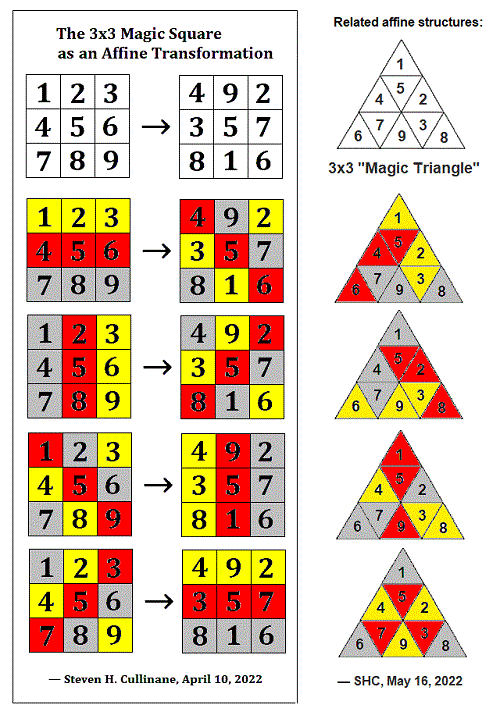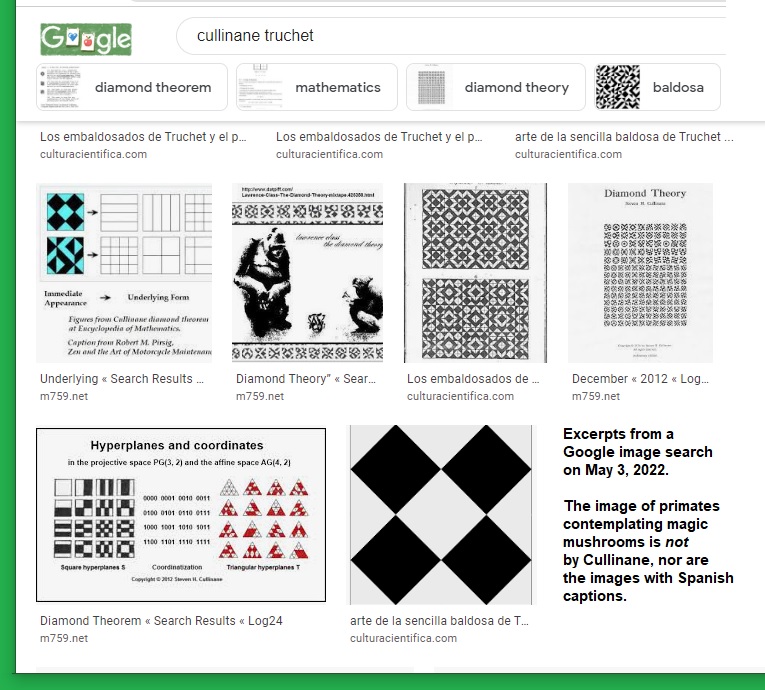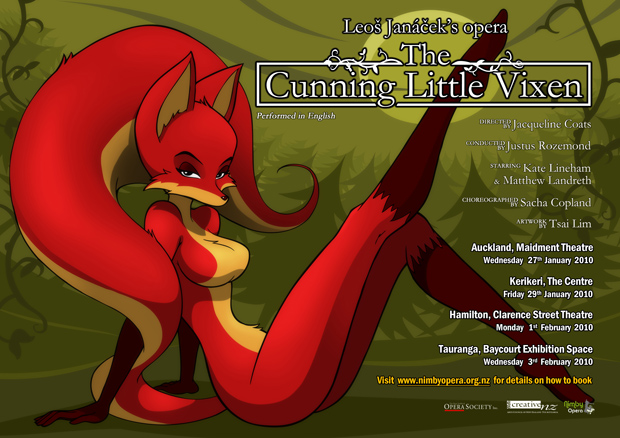Social Geometry, Social Physics . . .
and now Social Class —
* See other posts so tagged.
For the late actor Kenneth Welsh, who reportedly died at 80
on May 5, 2022 …
A Log24 search — Edmonton.
|
Jason Kehe at WIRED today — "The Real Reason Matrix Resurrections Bombed" . . . . "Lana Wachowski’s film practically burns with mirrors, with self-scrutiny. The very first shot is of an upside-down someone walking toward us. It’s a reflection, it turns out, in a puddle. We’re in for inversions and reversals, Wachowski is signaling, and not just cinematographically. The first third of the movie or so recapitulates the events of the first Matrix, but badly, unconvincingly. 'Why use old code,' one character asks, 'to mirror something new?' The movie critiques, even hates on, itself. It looks in the mirror and doesn’t like what it sees." . . . . |
Dr. Robert Ford — "Analysis."
* Title suggested by a textbook.
See "High Life" in this journal.
An image from Slovenia missed earlier* in the search above —
"Et cetera, et cetera, et cetera." — Oscar Hammerstein
* See "Robin Wilson" in the Design Grammar post of
19 Oct. 2017. The author of the above document may
or may not be the Robin Wilson of Gresham College.
The New York Times this afternoon —
From Log24 on the Catholic dies natalis of
the von Trapp daughter above —
|
"Literature is not demography, nor is it politics, even if it is quite often political. Progress, at least when it comes to cultural production, becomes lasting not when one is trying to join the reigning establishment, or lamenting how exclusionary it is (it so often is!), but, to quote that anti-Semite Ezra Pound, when one seeks, in the first place, to make it new ."
— Mordechai Levy-Eichel and Daniel Scheinerman on |
And then there are methodological sinkholes —
See Log24 posts tagged Sinkhole and . . .

See also . . .
http://m759.net/wordpress/?s=Prism .
Further searching, on the wider Web, yields . . .
"Blair has multiple sclerosis, a condition Didion shared."
— Susan Burton, review of Mean Baby , NY Times 15 May 2022
Another recent narrative about Didion and MS —
|
March 3rd, 2022 by Emily Carmichael |
Daniel Radcliffe in the recent film "The Lost City" —
|
301
302
303
304 |
From the Log24 post "Fish Babel" —
The final page, 759, of the Harry Potter saga —
|
Sunday, July 14, 2013
Working Backwards
|
|
"I twisted my mind like a bright ribbon, folded it,
"All manner of thing shall be well |
See also some context for these quotations.
"By a knight of lines and shadows
I summoned am to tourney…"
— Adapted from "Tom O' Bedlam's Song"


Updates from later the same day —
Related affine structures —

See also "Square+Triangles" in this journal.
The fishlike shapes within three of the above
ninefold colored triangles suggest some . . .
Related Entertainment —

See also posts tagged "Will the Circle" and a Carter family song.
(The YouTube upload date on that song is not without interest.)
"Turn on, tune in …"
https://webusers.imj-prg.fr/~leila.schneps/
grothendieckcircle/Spirituality/Spirituality19.pdf
Fred Ward, an actor, reportedly died on Sunday, May 8, 2022.
Music that was used on the soundtrack of one of his films —
In memory of Ward and Nin-Culmell — See Jan. 14, 2004, in this journal.
A new article on Norwegian artist Josefine Lyche was added
to the Norwegian Wikipedia on May the Fourth, 2022.
Meanwhile . . .
USA Today — "Finland shares an 830-mile border with Russia."
Also bordering Russia … Norway. See the art of Josefine Lyche
at the only legal land Russia-Norway border crossing.
In memory of an actor who reportedly died on May 7 —
"Mr. Jenkin's play aspires to a Borgesian take on
American cultural rubble (pulp novels, films noir,
diner menus, pop songs, etc.), here assembled into
a labyrinthine, coincidence-driven and self-consciously
artificial plot." — Ben Brantley, New York Times ,1996

Related reading:
Shibumi: A Novel
and
"The Diamond Theorem
in Basque Country."
|
A Story That Works
“There is the dark, eternally silent, unknown universe;
and lastly, there is lonely, story-telling, wonder-questing, – Fritz Leiber in “The Button Molder“ |
♫ "Will the record be unbroken . . . ?"
— Adapted song lyric
A link to
https://www.newyorker.com/magazine/
2022/05/16/how-queer-was-ludwig-wittgenstein
appeared today in my RSS feed as . . .
Related remarks: Art Space, a Log24 post of 7 May 2017.
The art above is by one Alexis Beauclair. See as well
an earlier illustration, also credited to Beauclair —
From the Centre de recherches mathématiques (CRM) —
Related remarks —
"The form, the pattern" — T. S. Eliot — and . . .
See as well the new URLs ternary.space and ternary.group.
A tune from the conclusion of Episode 1 of Season 3,
"A Discovery of Witches" —
I prefer the Carter Family version and, from the YouTube upload date
of the above British version . . .
From a Wikipedia article suggested by the previous post —
"A recurring theme among these characters
is that a dead human has been reanimated
with cybernetic technology."
"Tamen usque recurret . . . ." (Phrase originally from Horace.)
Related material — Posts tagged Interality and Seven Seals.
From Hermann Weyl's 1952 classic Symmetry —
"Galois' ideas, which for several decades remained
a book with seven seals but later exerted a more
and more profound influence upon the whole
development of mathematics, are contained in
a farewell letter written to a friend on the eve of
his death, which he met in a silly duel at the age of
twenty-one. This letter, if judged by the novelty and
profundity of ideas it contains, is perhaps the most
substantial piece of writing in the whole literature
of mankind."
Update to yesterday's "Use Your Noodle" post . . .
Click the above image to enlarge.
Update of 2:40 AM May 7, 2022 —
Flusser's seven "pillars" appear to be the main sections of the Tractatus
— numbered 1 through 7, with many intermediate numbered passages.
For a more geometric meditation on "the shape of things," see other
posts tagged "Shape Constant" in this journal.
Related material —
"A good, involving mystery featuring strong characters and
prose as smooth as the brim of a fedora, this novel makes
smart points about writing, publishing and the cult of mysteries."
— Review of A Smile on the Face of the Tiger
See also . . .
An essay from . . .
The Shape of Things: A Philosophy of Design Wittgenstein’s Architecture The universe of texts can be seen as a landscape. In it one can make out mountains and valleys, rivers and lakes, castles, farmyards and inner-city slums. On the horizon of the scene visualized in this way, the Bible and Homer appear as gigantic ice-covered mountains. The vast, tranquil lake of Aristotle’s texts, where fishermen idly throw their nets and philologists row their boats, occupies a part of the valley bottom. There, the tumbling waterfall of Nietzsche is captured by the broad river of modern pragmatism. Towering above everything, the Gothic cathedral of St Thomas Aquinas’s Summae dominates the cathedral square of the city, in which the roofs and gables of Baroque speculations jostle one another. In the suburbs of this city, one catches sight of the Romantic, Realist and Modernist housing-blocks and factories of more recent litera¬ ture; somewhat apart from all these stands a small, apparently insignificant house resembling scaffolding more than a finished building: Wittgenstein’s building. This little house is called the Tractatus. This name isn’t the product of a one-track mind. For when one enters the house, one notices immediately that this is not a place that has lost track of things. Quite the opposite: It is a place of mirror- images. The house stands on six foundation pillars which support one another by means of cross-beams organized in a hierarchy. In the middle, however, there rises a seventh pillar whose function it is to cut through the building and free it from the ground. So the house with all its corners, angles and joints is protected, armoured and impregnable. And yet, and for that very reason, it is threatened with collapse and disappearance without trace – condemned in advance and from the outset. The building is set out: It consists of propositions. Every proposition presupposes all the preceding ones and is itself the 76 presupposition of all the following propositions. Proposition by proposition, anyone who enters progresses through the prescribed rooms, and his step is supported by consistencies. Suddenly, with one proposition, one single proposition, the ground gives way beneath his feet. He falls head first into the abyss. Wittgenstein’s house is situated in a suburb of that city whose cathedral square is dominated by the towers of Thomas Aquinas’s cathedral. The small, modest pillars of Wittgenstein’s house support one another according to the same logico- philosophical method as the pillars of the cathedral support one another. But there appears to be a world of difference between the cathedral and the little house: The cathedral is a ship pointing in the direction of heaven, and the little house is a trap-door pointing in the direction of a bottomless abyss. But be careful: May Thomas Aquinas not have been right in saying after his revelation that everything he had written before was like straw? May not the heaven above the cathedral be the same black hole as the abyss beneath the little house? May not Wittgenstein’s little house be the cathedral of today? And those mirrors whose images simultaneously mirror one another, may they not be our equivalent of stained-glass windows? The landscape portrayed in this essay, it goes without saying, is a metaphor. Is it possible to identify it as Vienna? And is it possible for anyone entering Wittgenstein’s little house in that unlikely place to make out a hint of the unsayable? What we cannot speak about we must pass over in silence. 77 |
Click the above image to enlarge.
See as well . . .
Update of 2:40 AM May 7, 2022 —
Flusser's seven "pillars" appear to be the main sections of the Tractatus
— numbered 1 through 7, with many intermediate numbered passages.
For a more geometric meditation on "the shape of things," see other
posts tagged "Shape Constant" in this journal.
*Byron Gogol is a tech magnate in the HBO series "Made for Love."

WIkipedia on the URL suffix ".io" —
"In computer science, "IO" or "I/O" is commonly used
as an abbreviation for input/output, which makes the
.io domain desirable for services that want to be
associated with technology. .io domains are often used
for open source projects, application programming
interfaces ("APIs"), startup companies, browser games,
and other online services."
An association with the Bead Game from a post of April 7, 2018 —
|
Glasperlenspiel passage quoted here in Summa Mythologica —
“"I suddenly realized that in the language, or at any rate A less poetic meditation on the above 4x4x4 design cube —
"I saw that in the alternation between front and back, See also a related remark by Lévi-Strauss in 1955:
"…three different readings become possible: |
The recent use by a startup company of the URL "interality.io" suggests
a fourth reading for the 1955 list of Lévi-Strauss — in and out —
i.e., inner and outer group automorphisms — from a 2011 post
on the birthday of T. S. Eliot :
A transformation:
Click on the picture for details.
See "Flusser and the I Ching," by Peter Zhang.
Zhang has written extensively on the concept of "interality,"
a term coined by his colleague Geling Shang.
For interality as the mathematics underlying the natural
automorphism group of the I Ching, see my own work.

See also "Interality" in this journal.
Update of 8:56 AM ET
Friday, May 6, 2022:
“You have to all have a shared language of all this stuff,
otherwise it can get pretty confusing,” Waldron said.
The Waldron quote is from . . .
Later, at 9:29 AM ET . . .
See as well other posts now tagged Strange Change.
In memory of a comic-book artist —
His views on physics at
http://web.archive.org/web/20060805085915/
http://nealadams.com/PhysicsOfGrow.html
… and a New Yorker cartoon from
his reported date of death — April 28 —


"Los embaldosados" means the tilings .
The image referencing Robert M. Pirsig is
from "Classic Romantic," Dec. 19, 2020.
"Moon Knight" will conclude at 3 AM ET Wednesday.
Related art —

Related cinematic art — ("Tomb Raider," 2018) —
An image that some — perhaps even Uncle Walt himself —
might prefer to the above depiction of Lara Croft —

" While quantum theory has proven to be supremely successful
since its development a century ago, physicists have struggled to
unify it with gravity to create one overarching ‘theory of everything.’ "
— News release 1-May-2022 from
Foundational Ouestions Institute, FQXi
See as well the new URL "overarching.group."
From a 2017 Kate Mara film —
For a rather different vision of perfection, see Mara in "Morgan" (2016).


The pane number of interest — 15 or 14 ? —
depends on your perspective.
Related cinematic art of Oscar Isaac —

"Edward Bulwer-Lytton (infamous author of the opening line,
'It was a dark and stormy night') was a Victorian-era writer.
In 1870, he published a science fiction novel, The Power of
the Coming Race, which describes an underground race of
superhuman angel-like creatures and their mysterious energy
force, Vril, an 'all-permeating fluid' of limitless power."
— From a source linked-to in the post Vril Chick.
"Credit where credit is due" . . .
* See the previous two posts, now also tagged Play Room.
"Damning revelations" — Marie Claire yesterday
|
"Imagine a powerful man as a ship, like the Titanic. That ship is a huge enterprise. When it strikes an iceberg, there are a lot of people on board desperate to patch up holes — not because they believe in or even care about the ship, but because their own fates depend on the enterprise."
— Op-ed attributed to Amber Heard by The Washington Post , |

"Nor mouth had, no nor mind, expressed
What heart heard of, ghost guessed:"
— Two lines from a Gerard Manley Hopkins poem
as quoted by Caleb Murdock at . . .
https://www.ablemuse.com/erato/showthread.php?t=5356 .
From that same URL —
"And, Caleb, yes, 'sprung rhythm' has made it into dictionaries,
though even there, the association is with Hopkins."
For guess-ghosts —
"Spring is sprung, the grass is riz,
I wonder where the flowers is."
And for an able muse —


Translated by Google as . . .
The Truchet Tiles and the Diamond Puzzle and
The Art of the Simple Truchet Tile.
About the author:
Raúl Ibáñez is a professor in the Department of Mathematics
at the UPV/EHU and collaborator with the Chair of Scientific Culture.
About his school:
The University of the Basque Country
(Basque: Euskal Herriko Unibertsitatea, EHU ;
Spanish: Universidad del País Vasco, UPV ; UPV/EHU)
is a Spanish public university of the Basque Autonomous Community.
— Wikipedia

Illustration by Nicholas Konrad / The New Yorker April 28, 2022
Some related material from Harvard —
From The New York Times on May 5, 2011 —
"… What Paris says to me is love story, awash with painters,
shots of the Seine, Champagne. Thank God I have a
can’t-miss notion to sell you. I call it ‘Midnight in Paris.’ ”
“Romantic title,” I had to admit. “Is there a script?”
“Actually, there’s nothing on paper yet, but I can spitball
the main points,” he said, slipping on his tap shoes.
“Maybe some other time,” I said, mindful of Cubbage’s
unbroken string of theatrical Hiroshimas.
— Woody Allen
The above passage is in memory of a French film director
who, like the reporter in yesterday's post Primary Colors,
reportedly died on April 21, 2022.
See also Aitchison at Hiroshima and Easter for Aitchison.
"Leslie Jamison has written an honest and important book….
All in all, vivid writing and required reading." ―Stephen King
Meanwhile, also on April 5, 2018… See posts tagged D8.
More recently, in a conspicuously un-dated new literary magazine …
See as well Freud on the Tummelplatz .
From a post of October 25, 2002 —
"A work of art has an author and yet,
when it is perfect, it has something
which is essentially anonymous about it."
— Simone Weil, Gravity and Grace
This flashback was suggested by a quotation
in today's previous post —
"Go back to the darkest roots of civilisation
and you will find them knotted round
some sacred stone or encircling
some sacred well."
— G. K. Chesterton, Orthodoxy , Ch. 5 —
"The Flag of the World."
"Go back to the darkest roots of civilisation
and you will find them knotted round
some sacred stone or encircling
some sacred well."
— G. K. Chesterton, Orthodoxy , Ch. 5 —
"The Flag of the World."
See also . . .
|
Tuesday, November 3, 2009 Filed under: General,Geometry — Tags: Glasperlenspiel, Solomon Marcus — m759 @ 10:10 PM Book review by Jadran Mimica in Oceania, Vol. 74, 2003: "In his classic essay of 1955 'The Structural Study of Myth' Levi-Strauss came up with a universal formula of mythopoeic dynamics [fx(a) : fy(b) :: fx(b) : fa-1(y)] that he called canonical 'for it can represent any mythic transformation'. This formulation received its consummation in the four massive Mythologiques volumes, the last of which crystallises the fundamental dialectics of mythopoeic thought: that there is 'one myth only' and the primal ground of this 'one' is 'nothing'. The elucidation of the generative matrix of the myth-work is thus completed as is the self-totalisation of both the thinker and his object." So there. At least one mathematician has claimed that the Levi-Strauss formula makes sense. (Jack Morava, arXiv pdf, 2003.) I prefer the earlier (1943) remarks of Hermann Hesse on transformations of myth: "…in the spirit of the Glass Bead Game, everything actually was all-meaningful, that every symbol and combination of symbols led not hither and yon, not to single examples, experiments, and proofs, but into the center, the mystery and innermost heart of the world, into primal knowledge. Every transition from major to minor in a sonata, every transformation of a myth or a religious cult, every classical or artistic formulation was, I realized in that flashing moment, if seen with a truly meditative mind, nothing but a direct route into the interior of the cosmic mystery, where in the alternation between inhaling and exhaling, between heaven and earth, between Yin and Yang, holiness is forever being created." |
|
Derrida was the final speaker on the final day. He remained a silent observer for much of the symposium. He looked on as Lacan rose to his feet with obscure questions at the end of each lecture, and as Barthes gently asked for clarification on various moot points. Eventually, however, Derrida, unused to speaking to large audiences, took to the stage, quietly shuffled his notes, and began, ‘Perhaps something has occurred in the history of the concept of structure that could be called an “event”…’ He spoke for less than half an hour. But by the time he was finished the entire structuralist project was in doubt, if not dead. An event had occurred: the birth of deconstruction.
Salmon, Peter. An Event, Perhaps (pp. 2-3). |
Salmon today at Arts & Letters Daily —
* Vide "pleasantly discursive" in this journal.
October 2, 2016, was, in the Catholic sense, the dies natalis
of a philosopher of science, Mary Hesse.
October 2 was also the day of birth, in the non-Catholic sense,
of philosopher-poet Wallace Stevens.
Cf. remarks in this journal on October 2, 2016.
See as well Morse in Log24 posts on the Go chip.
Excerpt from a long poem by Eliza Griswold —
The square array above does not contain Arfken's variant
labels for ρ1, ρ2, and ρ3, although those variant labels were
included in Arfken's 1985 square array and in Arfken's 1985
list of six anticommuting sets, copied at MathWorld as above.
The omission of variant labels prevents a revised list of the
six anticommuting sets from containing more distinct symbols
than there are matrices.
Revised list of anticommuting sets:
α1 α2 α3 ρ2 ρ3
γ1 γ2 γ3 ρ1 ρ3
δ1 δ2 δ3 ρ1 ρ2
α1 γ1 δ1 σ2 σ3
α2 γ2 δ2 σ1 σ3
α3 γ3 δ3 σ1 σ2 .
Context for the poem: Quark Rock.
Context for the physics: Dirac Matrices.
For a weblog post today on an auction item from
the collection of the late Pierre Le-Tan.
A search for information on Le-Tan reveals that his
dies natalis (in the Catholic sense) was Sept. 17, 2019.
See a poem quoted here on that date in posts tagged Quark Rock.
"Spirits rise . . . ." — Streisand
Related material —
A 1920 play by J. M. Barrie, recreated on stage and now in film.
https://blacklistdeclassified.net/2022/04/15/
%f0%9f%94%b4-script-916-helen-maghi/ —
Red: If I may offer some counsel –
“Do not go where the path may lead.
Go instead where there is no path
and leave a trail.”
In the spirit of that, I bring an unusual case….
This post is in honor of Thandiwe Newton,
who left a Westworld trail —
Vide Bulk Apperception.
* Cf. a post from Day 3 of 2022.

* See other posts tagged Aitchison in this journal.
For the De las Cuevas above, see …
https://www.gemmadelascuevas.com/ —
"I am an Assistant Professor at the Institute for Theoretical Physics
at the University of Innsbruck (Austria) . . . ."
— and a tweet from Thursday, April 14, 2022, that indicates
an interest in philosophy as well as physics —
Related vocabulary —
Related drama —
Draft of a letter to FDR written by Leo Szilard
and signed by Albert Einstein —
For the letter as sent , see a webpage on the Manhattan Project.
This post was suggested by a New York Times obituary today that
contained the following misleading description —
"a 1939 letter from Albert Einstein to President Franklin D. Roosevelt
encouraging the American effort to build the atomic bomb."
There was apparently no such effort until after the letter was received.
From the 2019 post Spring Loaded —
A more recent image, from Carroll's wife Jennifer Ouellette —
For a more sophisticated approach to the 4x4x4 cube,
see a page at finitegeometry.org.
From the previous post —
Many will prefer snazzier potions —
These were available as NFTs recently . . .
See some.place. And then there is nine.place.
"It’s important, as art historian Reinhard Spieler has noted,
that after a brief, unproductive stay in Paris, circa 1907,
Kandinsky chose to paint in Munich. That’s where he formed
the Expressionist art group Der Blaue Reiter (The Blue Rider) —
and where he avoided having to deal with cubism."
— David Carrier,

Images from an earlier Christmas Day, in 2005 —
"Jesus Christ, Adam. I need you to play it cool."
See as well this journal on February 10, 2010 —
A Midrash for Levy —

That was then, this is now —

Be careful what you wish for.

For the Unicorn School —
<time class="_1o9PC"
datetime="2022-04-10T06:41:25.000Z"
title="Apr 10, 2022">4 hours ago
</time>
From posts tagged Unicorn Language —
Some will prefer the Dragon School . . .
of Tom Hiddleston, Emma Watson, and Humphrey Carpenter.
"National Unicorn Day" was yesterday . Today's mythical creature —
the villainous spymaster of The Eiger Sanction , Yurasis Dragon.
The previous post was in memory of one Eleanor Munro.
A different literary Munro —
And then there is Hector Hugh Munro, pen name Saki . . .
See lumber room in this journal (Nov. 30 – Dec. 3, 2016), and
later Ghost Ship tales in a post of December 22, 2016.
The author of the above title is featured in
a New York Times obituary today. Another
book by the same author, On Glory Roads,
appears in some related readings here .
Also on the above publication date —
Conrad K. Die beginnende Schizophrenie.
Stuttgart, Germany: Thieme Verlag; 1958.
Conrad K. Gestaltanalyse und Daseinsanalytik.
Nervenarzt. 1959; 30: 405–410.
"Reviewing Ms. Allen’s staging of Ibsen’s
'When We Dead Awaken'
at Stage West in 1977, Mr. Barnes wrote that
it had 'speed, conviction and perception.'"
— Richard Sandomir today reviewing the life of Rae Allen.
From the conclusion of that Ibsen play —
"Pax vobiscum."
See as well the YouTube comments below, on Allen
in the film version (1958) of "Damn Yankees" —
Powered by WordPress